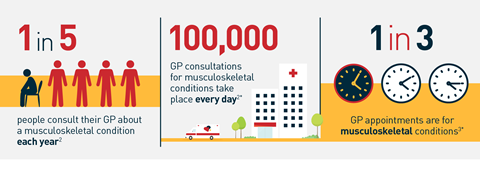Sponsored by
This article has been commissioned and funded by Pfizer Limited.
The impact of osteoarthritis (OA)-related pain goes far beyond patients and the people closest to them. At a national level, the socioeconomic burden is huge.1–5 Not only are musculoskeletal conditions such as OA a leading cause of lost working days,1 the direct effects on health service resources should also not be underestimated. So how much does OA-related pain truly cost the NHS – and crucially, what can we do to address this?
In the UK:

Most people who seek help for musculoskeletal conditions are treated in general practice, so it’s not surprising that much of the strain is felt in primary care. One third of over 45s in the UK have sought treatment for OA, totalling 8.75 million people2 – almost equivalent to the population of London.6 This places huge demand on already-stretched GP practices, leaving many patients facing delays and setbacks and feeling ‘lost in the system’.4 Even for those who are referred to secondary care, resources remain limited, with one or fewer pain specialists per 100,000 people.5
The total annual NHS spend related to arthritis and musculoskeletal conditions in England is roughly £5billion.2 And the situation is only likely to worsen in future, with an ageing population and rising rates of obesity.2
So what can be done to tackle the issue? We can’t control the number of patients seeking care, but we can make sure they receive the right care, in the right setting, from the right healthcare professional. A streamlined treatment pathway can deliver greater efficiency and can stop patients being bumped back and forth between different healthcare settings.
Change is already happening: for example, the length of hospital stays for joint replacement has fallen dramatically since the late 90s, resulting in substantial savings to the NHS.*7 But there’s still much more work to be done. We must continue to facilitate multidisciplinary working, with effective communication between all members of the team – from GPs and physiotherapists to orthopaedic surgeons, rheumatologists and pain specialists. And we must recognise the domino effects of chronic pain, taking a holistic approach to OA management that puts patients at the centre.
By taking action, we can begin to reduce the burden of OA-related chronic pain on both individual patients and the NHS as a whole. Visit whatischronicpain.co.uk to find out more.
*Data for England only.
1. Versus Arthritis. Available at: https://www.versusarthritis.org/media/14594/state-of-musculoskeletal-health-2019.pdf [Accessed May 2021].
2. Versus Arthritis. Available at: https://www.versusarthritis.org/media/2115/osteoarthritis-in-general-practice.pdf [Accessed May 2021].
3. NHS. Available at: https://www.longtermplan.nhs.uk/wp-content/uploads/2019/08/nhs-long-term-plan-version-1.2.pdf [Accessed May 2021].
4. ARMA. Available at: http://arma.uk.net/wp-content/uploads/2019/10/Chronic_Pain_Report_V8_APPROVED-07102019.pdf [Accessed May 2021].
5. McGhie J et al. BJA. 2016;116(2):159–162.
6. Trust for London. Available at: https://www.trustforlondon.org.uk/data/geography-population/ [Accessed June 2021].
7. Burn E et al. BMJ Open. 2018;8(1):e019146.
PP-PPF-GBR-0124 | July 2021



























